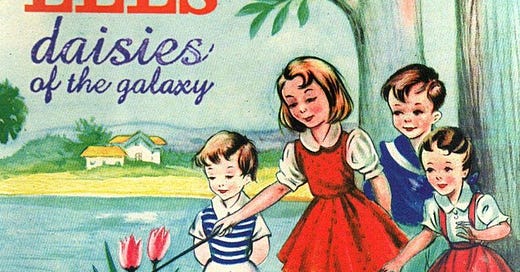The load on the road brings a tear to the Indian's eye
Eels - 'Mr E's Beautiful Blues' (Daises of The Galaxy - 2000)
I am sure that the two UK top tens Eels had in the mid-1990s, ‘Susan’s House’ and, to a lesser degree, ‘Novocaine For The Soul’, had punctuated my consciousness as I became a teenager. Certainly, Beautiful Freak’s cover was not easily forgotten if you’d seen it on bus shelters, telephone boxes and in magazines. By the time I was 16, however, I had two further exposures that would result from technology bringing more choices. My family moved house in early 2000 to an area of North Kent, which saw us get Sky Digital- which wasn’t an option in our old neighbourhood. This meant that I could no longer only see music videos on The Box, MTV and VH1 but also, amongst others, the far more esoteric MTV|2, no doubt the first place that I saw the carrot-clone video of ‘Last Stop: This Town’.
I could also access XFM on 104.9fm on the radio as the likes of Christian O'Connell, Eddie Temple-Morris, Zane Lowe, and Claire Sturgess had a clearer pathway to my radio. This meant, and this may surprise those who listen to Radio X now or see what the listeners think are the best British songs ever, but it was far more alternative in 2000 (though not as leftfield as when it started.) It gave me something outside of John Peel or The Evening Session on BBC Radio 1 that offered me what I wanted to hear. To that extent, I was easily able to replicate the heavily rotated songs from Spring 2000 in this playlist years later.
You’ll notice that the Eel's song is ‘Flyswatter’, which was released at the end of June, but the first single from the album Daises of the Galaxy was the closing track. ‘Mr. E's Beautiful Blues’. A song which, like much of E’s (Mark Oliver Everett) previous work, masks poignant and deep lyricism with upbeat sounds and melodies. The song's lyrics juxtapose that cheerful refrain with darker, more introspective verses, encapsulating what I think is the essence of Eels' music—finding beauty amid pain and adversity. Beautiful Freak writ large.
One of the most memorable lines in the song is "The Indian in the Cherokee, the little Indian who cried." This line evokes what, for many in America at the time, was an iconic image from the 1970s public service announcement featuring Iron Eyes Cody, a Native American actor, shedding a tear over pollution.
For those elsewhere, it may well be the 1990s references from Wayne’s World 2, which lampoons it in the aftermath of Waynestock or the closing scene of The Simpsons’ 200th and final episode.
E and Michael Simpson of the Dust Brothers produced ‘Mr. E's Beautiful Blues'. The production is characterised by a rich, layered sound that blends rock, pop, and folk elements. The song features a mix of acoustic and electric guitars, piano, and a prominent drum beat that drives the rhythm. Adding whimsical elements, such as the sound of birds chirping and playful keyboard riffs, enhances the song's light-hearted feel. At the same time, there is a polish to the production, a rawness to the song driven by all those disparate embellishments, and a slight kitchen sink approach. The song’s release as a single has made it one of the band’s most famous songs, in the top ten of most played songs according to setlist.fm, and helped push the album’s overall popularity.
For long-time readers, you might guess what is coming next. The song was not initially intended to be included on Daisies of the Galaxy. The song was added at the insistence of the record label, who recognised its potential as a hit single and had it placed as a hidden track on the CD.
It is interesting to think about an alternate world in which it wasn’t included and the album was less popular. Of course, that type of thinking is quite tied to E’s family as his father, Hugh Everett III, was a notable physicist who proposed the Many Worlds Interpretation (MWI) of quantum mechanics. This theory suggests that every possible outcome of a quantum event exists in its own separate universe, creating a vast multiverse of parallel realities.
This ground-breaking hypothesis has profoundly impacted physics and popular culture, influencing numerous works of fiction, including the Marvel multiverse.
The concept of the multiverse resonates with the themes in ‘Mr. E's Beautiful Blues and the parent album as a whole. The idea that multiple realities exist simultaneously mirrors the album's exploration of contrasting emotions and experiences. Just as the multiverse contains countless possibilities, the album navigates a spectrum of feelings, from despair to joy, reflecting the complexity of the human condition.





New subscriber....I'm from the States, more specifically, rural Alabama and when MTV2 first came out it in the mid 90's it was just M2 and was only available at first on the big giant satellite dishes that were prevalent in the rural areas where I lived that didn't have cable. It really opened my ears and eyes to so much music that never aired on MTV or was even played on the modern rock stations or was even too weird for 120 Minutes. Hammer and Tongs who did the Last Stop This Town video also did the incredible Coffee and TV video from Blur. I probably never would've discovered DJ Shadow, Aphex Twin, Ween, and Air among many, many others had it not been for that channel. We always hear how MTV changed music in the 80's, but we rarely, if never hear how M2 and it's free form and yes very esoteric playlist, changed alot of kids perspectives on music in the mid and late 90's.